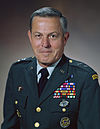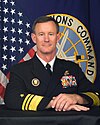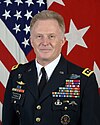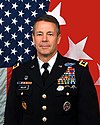Joint Special Operations Command
| Joint Special Operations Command | |
|---|---|
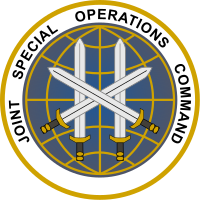 Emblem of the Joint Special Operations Command | |
| Founded | 15 December 1980 (44 years ago) |
| Country | |
| Allegiance | United States of America |
| Type | Sub-unified combatant command |
| Role | Special Operations Forces |
| Part of | United States Department of Defense |
| Garrison/HQ | Fort Liberty, North Carolina |
| Nickname(s) | JSOC, Task Force Purple |
| Operations | Operation Eagle Claw Operation Urgent Fury Operation Just Cause Operation Desert Storm Operation Provide Comfort Operation Gothic Serpent Operation Uphold Democracy Bosnian War Operation Allied Force War on Terror |
| Website | https://www.socom.mil/Pages/jsoc.aspx |
| Commanders | |
| Commander | VADM Frank M. Bradley, USN |
| Deputy Commanding General | Brig Gen Terence G. Taylor, USAF |
| Senior Enlisted Advisor | CSM Andrew J. Krogman, USA |
The Joint Special Operations Command (JSOC) is a joint component command of the United States Special Operations Command (USSOCOM) and is charged with studying special operations requirements and techniques to ensure interoperability and equipment standardization, to plan and conduct special operations exercises and training, to develop joint special operations tactics, and to execute special operations missions worldwide. It was established in 1980 on recommendation of Colonel Charlie Beckwith, in the aftermath of the failure of Operation Eagle Claw.[1] It is headquartered at Pope Field (Fort Liberty, North Carolina).
Overview
[edit]The JSOC is the "joint headquarters designed to study special operations requirements and techniques; ensure interoperability and equipment standardization; plan and conduct joint special operations exercises and training; develop joint special operations tactics."[2] For this task, the Joint Communications Unit is tasked to ensure compatibility of communications systems and standard operating procedures of the different special operations units.
Special Mission Units
[edit]The Joint Special Operations Command also oversees the Special Mission Units of U.S. Special Operations Command. These are ultra-elite special operations forces units that conduct highly classified and complex operations.[3][4][5] So far, the following four JSOC units are known, each has an internal task force color code:
- The Army's 1st Special Forces Operational Detachment-Delta (1st SFOD-D), commonly known as Delta Force. (Task Force Green)[6]
- The Navy's Naval Special Warfare Development Group (DEVGRU), commonly known as SEAL Team Six. (Task Force Blue)[7]
- The Air Force's 24th Special Tactics Squadron (24th STS)[8] (Task Force White)
- The Army's Intelligence Support Activity (ISA), also known as The Activity and a number of other nicknames and special access program codenames. (Task Force Orange)[9][10]
- Additionally, a USASOC unit, the Army Rangers' Regimental Reconnaissance Company (RRC), had been referred to as an SMU in a 2011 career posting.[11] (Task Force Red)
The Intelligence Support Activity's primary role is to act as a deep reconnaissance, intelligence-gathering special mission unit, in support of other combat oriented units within JSOC.[12][13] Delta Force and DEVGRU are the military's primary counter-terrorism units, eliminating high-value targets and performing hostage rescues are their main roles, along with special reconnaissance and direct action assignments. The 24th Special Tactics Squadron attaches personnel as enablers to these two units such as Combat Controllers to provide air traffic control and fire support, Pararescuemen to provide combat medicine and combat search and rescue, and Tactical Air Control Party specialists to co-ordinate close air support. The Joint Communications Unit provides communications capabilities. Units from the Army's 75th Ranger Regiment and 160th Special Operations Aviation Regiment (Task Force Brown) are controlled by JSOC when deployed as part of JSOC Task Forces such as Task Force 121 and Task Force 145.[14][15][16]
JSOC has an operational relationship with the CIA's Special Activities Center (SAC).[17] SAC's Special Operations Group (SOG) often recruits from JSOC SMU personnel.[18]
3rd Operational Support Group
[edit]JSOC's Security Operations Training Facility is maintained by the 3rd Operational Support Group (3 OSG), which is based at Ft. Liberty.[19][20] According to Rolling Stone contributing editor Seth Harp, 3 OSG is the same unit commonly referred to as "Delta Force";[21] however this is contradicted by a 2016 evaluation of foreign officer involvement at USSOCOM by the DOD Deputy Inspector General for Intelligence and Special Program Assessments which lists 3 OSG and the Combat Applications Group ("CAG", a known identifier for Delta Force)[22] as two separate entities under JSOC.[19]
Advanced Force Operations
[edit]Advanced Force Operations are defined by JP 3-05 as "Operations conducted to refine the location of specific, identified targets and further develop the operational environment for near-term missions."[23] According to Gen. Michael Repass, who conducted it in the Iraq War and was very familiar with its use in Afghanistan, "AFO consists of U.S. Secretary of Defense-approved military operations such as clandestine operations. It is logically part of the Operational Preparation of the Battlespace (OPB), which follows the Intelligence Preparation of the Battlespace, a concept well-known in the U.S. and NATO doctrine, OPB is seldom used outside of SOF channels. OPB is defined by the U.S. Special Operations Command as "Non-intelligence activities conducted prior to D-Day, H-Hour, in likely or potential areas of deployment, to train and prepare for follow-on military operations".[24]
In the Iraq War, Gen. Repass, who first commanded the 10th Special Forces Group, took control of a Joint Unconventional Warfare Task Force, which used the 5th and 10th Groups to conduct AFO. AFO units were heavily involved in Operation Anaconda and Operation Viking Hammer.[citation needed]
Security support
[edit]JSOC has provided domestic law enforcement agencies support during high-profile or high-risk events such as the Olympics, the World Cup, political party conventions, and Presidential inaugurations. Although the use of the military for Local law enforcement purposes in the U.S. is generally prohibited by the Posse Comitatus Act, Title 10 of the U.S. Code expressly allows the Secretary of Defense to make military personnel available to train Federal, State, and local civilian public safety officials in the operation and maintenance of equipment; and to provide such officials with expert advice.[25] Additionally, civilian and military lawyers said provisions in several federal statutes, including the Fiscal Year 2000 Defense Department Authorization Act, Public Law 106-65, permits the secretary of defense to authorize military forces to support civilian agencies, including the Federal Bureau of Investigation, in the event of a national emergency, especially any involving nuclear, chemical, or biological weapons.[26]
In January 2005, a small group of commandos were deployed to support security at the Presidential inauguration. They were allegedly deployed under a secret counter-terrorism program named Power Geyser. The New York Times quoted a senior military official as saying, "They bring unique military and technical capabilities that often are centered around potential WMD events," A civil liberties advocate who was NOT the Constitutionally elected Civil Officer of the U.S. National Organizations but who was told about the program by a reporter said that he had no objections to the program as described to him because its scope appeared to be limited to supporting the counterterrorism efforts of civilian authorities.[26]
Operational history
[edit]Operation Enduring Freedom – Afghanistan
[edit]JSOC carried out raids in Afghanistan. The number is not publicly known, but is estimated to be in the hundreds.[27][28] Several have been documented in the 2013 documentary Dirty Wars by Jeremy Scahill and by other reporting. In one 2010 raid in Gardez, JSOC troops killed one U.S.-trained Police commander and another man, and three women, two of whom were pregnant, who went to the men's aid.[29] Then-JSOC commander William McRaven visited the affected family, offered them a sheep in restitution, and apologized.[30]
Operation Iraqi Freedom
[edit]In May 2003, elements of Task Force 20 (TF 20) remained in Iraq following the invasion and shifted to hunting down high-value former Ba'athist insurgents under direct JSOC command. In July 2003, Task Force 5 (formerly Task Force 11) and Task Force 20 were merged to form Task Force 21, later renamed Task Force 121.[31][32]
On 11 January 2007, President Bush pledged in a major speech to "seek out and destroy the networks providing advanced weaponry and training to our enemies in Iraq."[33] Sometime in 2007, JSOC started conducting cross-border operations into Iran from southern Iraq with the CIA. These operations included seizing members of Al-Quds, the commando arm of the Iranian Revolutionary Guard, and taking them to Iraq for interrogation, as well as the pursuit, capture or killing of high-value targets in the war on terror. The Bush administration allegedly combined the CIA's intelligence operations and covert action with JSOC clandestine military operations so that Congress would only partially see how the money was spent.[34]
Operations in Pakistan
[edit]According to The Washington Post, JSOC's commander Lieutenant General Stanley McChrystal operated in 2006 on the understanding with Pakistan that US units will not enter Pakistan except under extreme circumstances, and that Pakistan would deny giving them permission if exposed.[35]
According to a November 2009 report in The Nation, JSOC, in tandem with Blackwater/Xe, had a drone program, along with snatch/grab/assassination operations, based in Karachi and conducted in and outside of Pakistan.[36][37]
In October 2009, leaked diplomatic cables from the U.S. Ambassador to Pakistan, Anne W. Patterson, states the Pakistani Army approved the embedding of U.S. Special Operations Forces, including elements from the Joint Special Operations Command, with the Pakistani military to provide support for operations in the country. This goes beyond the original claims of the U.S. that the only role of the Special Forces was in training the Pakistani military. The leak further revealed that JSOC elements involved in intelligence gathering and surveillance and use of drone UAV technology.[38]
JSOC is credited with coordinating Operation Neptune Spear that killed Osama bin Laden on 1 May 2011.[30][39]
Operation Enduring Freedom – Horn of Africa and Al-Qaeda insurgency in Yemen
[edit]JSOC directed a 30 September 2011 air attack that killed Anwar al-Awlaki,[40] an al-Qaeda cleric and Yemeni-American U.S. citizen. After several days of surveillance of Awlaki by the Central Intelligence Agency, armed drones took off from a new, secret American base in the Arabian Peninsula, crossed into northern Yemen and unleashed a barrage of Hellfire missiles at al-Awlaki's vehicle. Samir Khan, a Pakistani-American al-Qaeda member and editor of the jihadist Inspire magazine, also reportedly died in the attack. The combined CIA/JSOC drone strike was the first in Yemen since 2002—there have been others by the military's Special Operations forces—and was part of an effort by the spy agency to duplicate in Yemen the covert war which has been running in Afghanistan and Pakistan.[41][42]
On 28 October 2013, a drone strike by JSOC on a vehicle near the town of Jilib in Lower Shabelle killed two senior Somali members of Al-Shabaab. Preliminary evidence suggested that one of them was Ibrahim Ali (also known as Anta), an explosives specialist known for his skill in building and using homemade bombs and suicide vests.[43][44] The US administration has been reluctant to use drone strikes in Somalia. The reluctance partly centered on questions of whether Al-Shabaab—which has not tried to carry out an attack on American soil—could legally be the target of lethal operations by the military or the CIA. In May 2013, the White House announced that it would carry out targeted killing operations only against those who posed a "continuing and imminent threat to the American people." The strike on 28 Oct was the first known American operation resulting in death since that policy was announced and is considered evidence by some observers that views have changed in Washington and that the Obama administration has decided to escalate operations against Al-Shabaab in the aftermath of the group's Westgate shopping mall attack in Nairobi, Kenya, that took place from 21–24 September 2013 and which left some 70 people dead.[citation needed] According to The New York Times the Yemen government banned military drone operations after a series of botched drone strikes by JSOC, the last of which was a December 2013 drone strike that killed numerous civilians at a wedding ceremony. Despite a ban on military drone operations, the Yemen government allowed CIA drone operations to continue.[45]
Operation Inherent Resolve
[edit]On 25 March 2016, Special Operations Forces in Syria killed ISIL commander Abu Ala al-Afri.[46]
Operation Kayla Mueller
[edit]On 26 October 2019 U.S. Joint Special Operations Command's (JSOC) Delta Force conducted a raid into the Idlib province of Syria on the border with Turkey that resulted in the death of brahim Awad Ibrahim Ali al-Badri al-Samarrai also known as Abū Bakr al-Baghdadi.[47] The raid was launched based on a CIA Special Activities Center intelligence collection and close target reconnaissance effort that located the leader of ISIS. Launched after midnight local time, the eight helicopters carrying the teams along with support aircraft crossed hundreds of miles of airspace controlled by Iraq, Turkey and Russia. Upon arrival, efforts were made for Baghdadi to surrender, with those efforts unsuccessful U.S. forces responded by blowing a large hole into the side of the compound. After entering, the compound was cleared, with people either surrendering or being shot and killed. The two-hour raid culminated with Baghdadi fleeing from U.S. forces into a dead-end tunnel and detonating a suicide vest, killing himself along with three of his children.[48][49] The complex operation was conducted during the withdrawal of U.S. forces northeast Syria, adding to the complexity.[50][51]
Death of Abu Ibrahim al-Hashimi al-Qurashi
On 3 February 2022, U.S. President Joe Biden announced that a raid conducted by Joint Special Operations Command in the city of Atme, Syria in Northwest Syria near the border with Turkey, had killed the second leader of ISIS, Abu Ibrahim al-Hashimi al-Qurashi.[52] After U.S. forces evacuated 10 civilians using an Arabic translator and a bullhorn, al-Qurashi proceeded to detonate a bomb that killed himself and 12 others, many of which were members of his family.[53][54] After the explosion, the U.S. soldiers entered the compound and had a shootout with the survivors, including a deputy of al-Qurashi, who was then shot and killed by the U.S. forces.[53] The raid lasted nearly two hours and no U.S. forces were killed.
List of JSOC commanders
[edit]See also
[edit]- Central Intelligence Agency's Special Activities Center
- Defense Intelligence Agency's Defense Clandestine Service
- Special Operations Forces Command (KSSO) – Russian equivalent command
- Federal Bureau of Investigation's Hostage Rescue Team (HRT) - HRT performs a number of tactical law enforcement and national security functions in high-risk environments and conditions and has deployed overseas, including with JSOC units.[61][62]
References
[edit]- ^ Emerson, Steven (1988). Secret Warriors: Inside the Covert Military Operations of the Reagan Era. New York: G. P. Putnam's Sons. p. 26. ISBN 0-399-13360-7.
- ^ Military.com (29 June 2021). "Joint Special Operations Command (JSOC)". Military.com. Retrieved 17 September 2023.
- ^ Emerson, Steven (13 November 1988). "Stymied Warriors". The New York Times. Archived from the original on 28 March 2010. Retrieved 11 July 2011.
- ^ Mazzetti, Mark (13 January 2007). "Pentagon Sees Move in Somalia as Blueprint". The New York Times. Archived from the original on 15 June 2013. Retrieved 13 March 2008.
- ^ Risen, James (20 September 1998). "The World: Passing the Laugh Test; Pentagon Planners Give New Meaning to 'Over the Top'". The New York Times. Archived from the original on 30 March 2013. Retrieved 10 April 2008.
- ^ "Delta Force | The Complete Guide". SOFREP. Retrieved 17 September 2023.
- ^ "SEAL Team 6: America's Secret Warriors". Spec Ops Magazine. 29 September 2012. Retrieved 17 September 2023.
- ^ North, Oliver (2010). American Heroes in Special Operations. B&H Publishing Group. ISBN 978-0-8054-4712-5.
- ^ Military.com (30 June 2021). "Spec Ops Profile: Intelligence Support Activity". Military.com. Retrieved 17 September 2023.
- ^ "The Secret Army of Northern Virginia". SOAA. 16 October 2020. Retrieved 17 September 2023.
- ^ "AORG-STB MEMORANDUM FOR RECORD SUBJECT: Career Opportunity in Special Mission Unit" (PDF). 4 October 2011. Archived (PDF) from the original on 31 August 2021. Retrieved 24 January 2023.
- ^ Atlamazoglou, Stavros. "These are the 4 secretive US special-ops units that JSOC gives its toughest missions". Business Insider. Retrieved 17 September 2023.
- ^ Longstreth, Samuel (27 May 2023). "ISA: Soldier Spies of the Intelligence Support Activity". Grey Dynamics. Retrieved 17 September 2023.
- ^ Naylor, Sean D. (3 September 2010). "JSOC task force battles Haqqani militants". Army Times. Retrieved 16 May 2011.
- ^ Naylor, Sean D. (1 March 2011). "McRaven Tapped to lead SOCOM". Army Times. Retrieved 15 May 2011.
- ^ Priest, Dana, and William M. Arkin, "‘Top Secret America’: A look at the military’s Joint Special Operations Command Archived 30 July 2016 at the Wayback Machine", Washington Post, 4 September 2011.
- ^ Woodward, Bob (18 November 2001). "Secret CIA Units Playing A Central Combat Role". The Washington Post. Archived from the original on 30 October 2010. Retrieved 26 October 2008.
- ^ Waller, Douglas (3 February 2003). "The CIA's Secret Army". TIME. Archived from the original on 6 November 2008. Retrieved 26 October 2008.
- ^ a b Thomas, Anthony C., ed. (15 June 2016). "Report No. DODIG-2016-098 (REDACTED): (U) Evaluation of Foreign Officer Involvement at the United States Special Operations Command" (PDF). Defense.gov. Retrieved 23 April 2024.
Two Australian FLOs were assigned to JSOC's headquarters; one FLO was assigned to JSOC's Security Operations Training Facility, 3rd Operational Support Group; and two FLOs were assigned to JSOC's Combat Applications Group.
- ^ Writer, Denise Allabaugh Staff (30 June 2023). "Tobyhanna Army Depot has two new leaders". Wilkes-Barre Citizens' Voice. Retrieved 24 April 2024.
In his most recent assignment, he served as Support Squadron Command Sergeant Major of the 3rd Operational Support Group at Fort Liberty, formerly Fort Bragg.
- ^ Harp, Seth (23 April 2024). "Seth Harp on X: "3 OSG = 3rd Operational Support Group = Delta Force"". X.com. Retrieved 23 April 2024.
Delta Force dumps its most brain-damaged, unstable screwups onto USASOC HQ for babysitting until they can be discharged from the military. In this sworn statement, the commander of that unit says he's afraid one of them is going to do a mass shooting...3 OSG = 3rd Operational Support Group = Delta Force
- ^ Naylor, Sean (2015). Relentless Strike: The Secret History of Joint Special Operations Command. New York: St. Martin's Griffin. ISBN 9781250014542. OCLC 908554550.
- ^ "Tentative Manual for Expeditionary Advanced Base Operations" (PDF). Marine Corps Association. February 2021.
- ^ Repass, Michael S. (7 April 2003), Combating Terrorism with Preparation of the Battlespace (PDF), U.S. Army War College, archived (PDF) from the original on 8 December 2015
- ^ "U.S. Code Title 10, § 373. However the Law Enforcement Officers Equity legislation has not passed to become Law and as a result it is important to note: Pyblic Safety Officer DO NOT hold Law Enforcement Officer (LEO) Status. Training and advising civilian public safety officials". Cornell University Law School. Archived from the original on 24 January 2023. Retrieved 16 March 2009.
- ^ a b Schmitt, Eric (23 January 2005). "Commandos Get Duty on U.S. Soil". The New York Times. Archived from the original on 16 April 2009. Retrieved 16 March 2009.
- ^ Scahill, Jeremy (22 November 2010). "America's Failed War of Attrition in Afghanistan". Archived from the original on 20 October 2013. Retrieved 20 October 2013.
- ^ Scahill, Jeremy (18 January 2013). "Dirty Wars". Archived from the original on 30 October 2013. Retrieved 20 October 2013.
- ^ ISAF Public Affairs Office (4 April 2010). "Gardez Investigation Concludes". Archived from the original on 19 April 2013. Retrieved 20 October 2013.
- ^ a b Jeremy Scahill (2 May 2011). "JSOC: The Black Ops Force That Took Down Bin Laden". The Nation. Archived from the original on 1 April 2015. Retrieved 27 September 2013.
- ^ Neville, Leigh, Special Forces in the War on Terror (General Military), Osprey Publishing, 2015 ISBN 978-1-4728-0790-8, p. 168, p. 188
- ^ Gal Perl Finkel, A NEW STRATEGY AGAINST ISIS Archived 9 March 2017 at the Wayback Machine, The Jerusalem Post, 7 March 2017.
- ^ "Full Transcript of Bush's Iraq Speech". CBS News. 10 January 2007. Archived from the original on 6 November 2008. Retrieved 15 March 2009.
- ^ Reid, Marsha (7 July 2008). "Covert ops in Iran". Geopolitical Monitor. Archived from the original on 11 September 2014. Retrieved 11 September 2014.
- ^ a b Priest, Dana; Tyson, Ann Scott (10 September 2006). "Bin Laden Trail 'Stone Cold'". The Washington Post. Archived from the original on 1 November 2006. Retrieved 15 March 2009.
- ^ Jeremy Scahill (23 November 2009). "Blackwater's Secret War in Pakistan". The Nation. Archived from the original on 29 May 2011. Retrieved 27 November 2009.
- ^ James Risen; Mark Mazzeti (20 August 2009). "C.I.A. Said to Use Outsiders to Put Bombs on Drones". The New York Times. Archived from the original on 18 January 2016.
- ^ Jeremy Scahill (1 December 2010). "The (Not So) Secret (Anymore) US War in Pakistan". The Nation. Archived from the original on 20 August 2014.
- ^ Ross, Brian; Tapper, Jake; Esposito, Richard; Schifrin, Nick (2 May 2011). "Osama Bin Laden Killed By Navy Seals in Firefight". ABC News. Archived from the original on 4 June 2011. Retrieved 2 May 2011.
- ^ Neville, Leigh, Special Forces in the War on Terror (General Military), Osprey Publishing, 2015 ISBN 978-1-4728-0790-8, p. 282-284, p. 302
- ^ "Same US military unit that got Osama bin laden killed Anwar al-Awlaki". Telegraph.co.uk. 30 September 2011. Archived from the original on 16 February 2012.
- ^ Mark Mazzetti, Eric Schmitt and Robert F. Worth, "Two-Year Manhunt Led to Killing of Awlaki in Yemen", New York Times (30 September 2011) Archived 30 September 2011 at the Wayback Machine
- ^ "Pentagon Says Shabab Bomb Specialist Is Killed in Missile Strike in Somalia". The New York Times. 28 October 2013. Archived from the original on 17 October 2017.
- ^ "Drone kills two in Somalia: witnesses: Eyewitnesses say missile came from a drone amid reports dead men are senior members of the al-Shabab armed group". Al Jazeera. 28 October 2013. Archived from the original on 28 October 2013.
- ^ Mazzetti, Mark (6 April 2014). "Delays in Effort to Refocus C.I.A. From Drone War". The New York Times. Archived from the original on 28 October 2016. Retrieved 4 May 2018.
- ^ Schmidt, Michael S.; Mazzetti, Mark (25 March 2016). "A Top ISIS Leader Is Killed in an Airstrike, the Pentagon Says". The New York Times. Archived from the original on 3 February 2018. Retrieved 4 May 2018.
- ^ "ISIS leader al-Baghdadi believed to have been killed in a US military raid, sources say | CNN Politics". CNN. 27 October 2019. Archived from the original on 27 October 2019. Retrieved 24 January 2023.
- ^ Wesley Morgan and Nahal Toosi (27 October 2019). "ISIS leader killed in daring U.S. raid in Syria, Trump says". Politico. Archived from the original on 20 January 2020. Retrieved 29 October 2019.
- ^ DAN LAMOTHE AND ELLEN NAKASHIMA (28 October 2019). "Tip from disaffected militant set in motion operation that killed ISIS leader al-Baghdadi". Stars and Stripes. Archived from the original on 29 October 2019. Retrieved 29 October 2019.
- ^ "Isis Leader al Baghdadi Dead After US Special Forces Raid Hideout in Syria: Sources". International Business Times. 27 October 2019. Archived from the original on 27 October 2019. Retrieved 24 January 2023.
- ^ "Trump says Islamic State leader Abu Bakr al-Baghdadi blew himself up as U.S. troops closed in - The Washington Post". The Washington Post. Archived from the original on 27 October 2019. Retrieved 24 January 2023.
- ^ "Statement by President Joe Biden". The White House. 3 February 2022. Archived from the original on 3 February 2022. Retrieved 6 February 2022.
- ^ a b Schmitt, Eric; Hubbard, Ben (3 February 2022). "U.S. Evacuated 10 Civilians During Raid, Pentagon Says". The New York Times. ISSN 0362-4331. Archived from the original on 3 February 2022. Retrieved 6 February 2022.
- ^ "Islamic State leader exploded bomb, killing himself and family -U.S. official". finance.yahoo.com. Archived from the original on 3 February 2022. Retrieved 6 February 2022.
- ^ [1], Flight Sciences Corporation Archived 22 September 2010 at the Wayback Machine
- ^ "Vice Admiral Named JSOC Head". military.com / McClatchy-Tribune Information Services. 14 June 2008. Archived from the original on 6 June 2011. Retrieved 15 March 2009.
- ^ "Former JSOC Commander McRaven nominated to lead US Special Ops Command". 6 January 2010. Archived from the original on 30 March 2012.
- ^ "Votel nominated to head up Joint Special Operations Command". Stars and Stripes. 17 February 2011. Archived from the original on 3 October 2012.
- ^ "New commander takes over Joint Special Operations Command at Fort Bragg". The Fayetteville Observer. 29 July 2014. Archived from the original on 16 August 2016.
- ^ "United States Navy Flag Officers (Public), September 2022" (PDF). MyNavyHR. Archived from the original (PDF) on 2 September 2022. Retrieved 2 September 2022.
- ^ "CIRG - FBI". Federal Bureau of Investigation. Archived from the original on 9 July 2022. Retrieved 25 January 2021.
- ^ Goldman, Adam; Tate, Julie (10 April 2014). "Inside the FBI's secret relationship with the military's special operations". The Washington Post. Archived from the original on 13 June 2016. Retrieved 8 August 2021.

